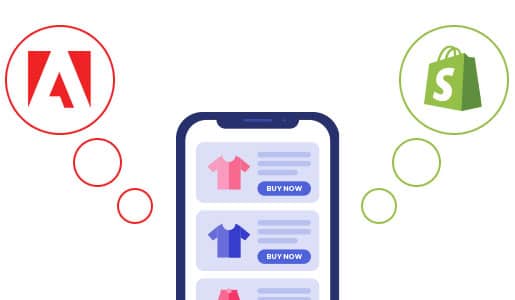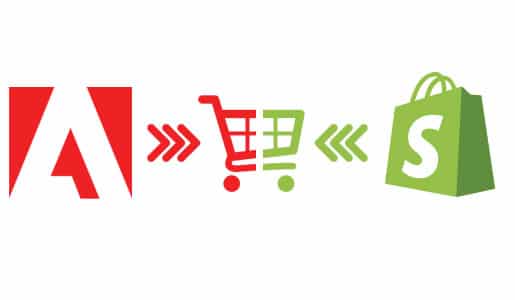
Ever wondered which eCommerce platform reigns supreme in the eCommerce world? Is it Adobe Commerce or Shopify? In the bustling world of online business, the debate between Adobe Commerce vs Shopify has never fizzled out. But wait! In case you want to know about Adobe Commerce vs Shopify, just follow this blog post.
Now, when you think of starting an online store, the immediate question that pops up in your mind is: which eCommerce platform to pick? Literally, with tons of options like- Adobe Commerce, BigCommerce, Shopify, PrestaShop, OpenCart, WooCommerce, etc., picking the right one is tricky.
Well, the list of such eCommerce platforms just goes on. However, for the eCommerce industry, the popular platforms are – Adobe Commerce, Magento, BigCommerce, and Shopify.
Adobe Commerce Vs Shopify: Which One Is for Me?

Well, as the digital landscape evolves, the Adobe Commerce vs Shopify debate is going to take center stage.
So, we need to understand that both platforms offer unique features, but which one truly stands out? For that, we must explore the ins and outs of Adobe Commerce vs Shopify. Then, we’ll delve into the key differences that set them apart.
Along the way, we’ll sprinkle in some fascinating insights to guide your decision. And by the end, the Shopify vs Adobe Commerce conundrum will become clear.
Remember in the world of online business, the debate about Adobe Commerce vs Shopify is going to last forever.
So, if you’re a seasoned business professional or a budding entrepreneur, this guide on Adobe Commerce vs Shopify is tailored just for you. So, what are we waiting for? Let’s get started!
Understanding the eCommerce Landscape in 2023
Well, in 2023 the eCommerce sector has taken a gigantic leap. Since more people are into online shopping than ever before, the digital marketplace is buzzing about the use of the right platform for their stores.
Interestingly, eCommerce sales are expected to grow 10.4% this year. Also, the global eCommerce market is expected to total $6.3 trillion in 2023. Moreover, it’s expected that the U.S. eCommerce market is going to reach over $1.1 trillion in sales in 2023. (Source: Forbes) That’s a clear testament to the growing importance of online shopping.
Introduction to Adobe Commerce and Shopify Platforms
Firstly, Adobe Commerce, formerly known as Magento, is a powerhouse in the eCommerce world. This platform is tailored especially for medium to large-scale businesses. Since, it is known to provide unparalleled customization and scalability.
On the other hand, Shopify is the perfect platform choice for small to medium-sized businesses. Why is it so? It’s simple because of its user-friendly interface. Plus, Shopify’s vast app ecosystem makes it a favorite option or choice among newbies and seasoned entrepreneurs alike.
So, why is the Adobe Commerce vs Shopify debate so heated? Well, both platforms offer unique features that cater to different business needs.
While Adobe Commerce provides in-depth customization options, Shopify prides itself on its ease of use.
Moreover, with the rise of mobile shopping, both platforms have upped their game, ensuring a seamless shopping experience across devices.
In conclusion, the Adobe Commerce vs Shopify showdown is more than just a comparison of features. It’s about understanding which platform aligns with your business goals and vision.
As we move forward, it’s crucial to stay informed and make choices that propel your business to new heights.
Adobe Commerce vs Shopify: Which One to Pick?
To have a better understanding of whether you should go for Shopify or Adobe Commerce, it’s crucial to look into the Shopify vs Adobe Commerce platforms in detail.
Wagento being a Adobe Commerce Partner can help you decide why Adobe Commerce excels over the Shopify platform.
So read on.
Adobe Commerce vs Shopify: Quick Platform Overview
Navigating the world of eCommerce can be a maze, especially when deciding between Adobe Commerce vs Shopify. To help you understand the uniqueness of the platform, go through the table we have provided.
Here’s a simple table to understand the two Platforms in detail.
Shopify vs Adobe Commerce: Overall Comparison
| Feature | Shopify | Adobe Commerce |
| Launched In | 2004 | 2015 |
| Ease of Use | Shopify’s got your back with its user-friendly interface. In short, easy to use. | Looking for more control and customization? Magento’s a bit complex, but it’s a powerhouse for those who know their way. |
| Source Code | Proprietary Source | Open Source |
| Hosting | Cloud-Based- | On-Site, Third-Party, and Cloud-Based |
| Extensions | 4000+ | 4600+ |
| Cost | From $29 | Free and Premium Editions |
| Security | SSL Certificate Included | Advanced Security & Regular Update |
| Design Flexibility | Choose from 8 free themes or go premium! Customize without coding. | Drag, drop, and design your heart out. Plus, personalize based on customer segments. |
| Sales Features | Integrated POS, inventory tracking, and cool features like local pickup. | Need B2B functions? Adobe Commerce comes integrated with B2B solutions. Plus, manage company accounts and handle credit seamlessly. |
| Reporting & Analytics | Daily sales insights, inventory reports, and more – all at your fingertips. | Dive deep into data with rich dashboards and visualizations. Know your business inside out. |
| Price Point | Perfect for those just starting out or on a budget. | It’s a bit on the pricier side, but hey, you’re investing in a robust platform for bigger business dreams! |
| Ease of Integration | Limited to Shopify API | Flexible |
| Theme Selection | 60+ | 12 from official Marketplace and 1000’s of Community created themes |
| Payment Gateways | Supports 70+ payment gateways. Charges an extra fee for payments via 3rd party providers | Comes with 3 built-in payment gateways and supports fast API-led integration of any third-party payment method. |
| Multilingual Capabilities | Doesn’t offer full multilingual capability. Third-party apps are needed. | Built-in Multilingual Support |
| Product Variants | Limited to 100 | Unlimited |
| Ideal For | Small Companies waiting to go online | Large enterprises with lot of resources |
Now, let’s simplify things with a quick overview of these two giants!
Adobe Commerce
Switching gears, let’s delve into the world of Adobe Commerce. This platform is mostly known for its robust and open-source nature. In fact, Adobe Commerce is a quite favorite among large-scale businesses.
Why is it so? The reason is pretty simple. It offers a level of customization and scalability that’s hard to match by any other platforms.
Originally known as Magento, Adobe Commerce has two main versions. The first, Magento Open Source, is free and caters to smaller businesses. However, on the downside, it comes with its own set of challenges, i.e., including the need for technical prowess.
On the other hand, the premium version of this platform, i.e., Adobe Commerce, comes with a licensing fee. The premium version is tailored for larger enterprises; since it comes with advanced features and dedicated support. When considering Adobe Commerce vs Shopify, it’s essential to understand these distinctions to make an informed choice.
Shopify
When you think of a platform that’s easy to use, Shopify immediately comes to mind. In fact, in the eCommerce world, it’s the poster child for user-friendliness.
It has been designed to keep beginners in mind. In fact, the best part about Shopify is that it offers a straightforward setup process. This means that even those who are new to online business can navigate with ease.
Moreover, it’s not just for newbies! Interestingly, many established businesses also prefer Shopify since its hassle-free maintenance and a vast array of tools. In essence, whether you’re just starting out or already have a booming business, Shopify caters to all. Adobe Commerce vs Shopify might seem like a tough choice, but for those who prioritize ease, Shopify often takes the lead.
In conclusion, the Adobe Commerce vs Shopify debate boils down to your business’s specific needs. While Shopify offers simplicity and a broad appeal, Adobe Commerce provides depth and flexibility, especially for larger ventures.
As we move further into the eCommerce world of 2023, making the right platform choice will be pivotal for your success. So, Adobe Commerce vs Shopify – which side are you on?
Adobe Commerce vs Shopify: Ease of Use
In the bustling arena of eCommerce, ease of use can make or break a business. When comparing Adobe Commerce vs Shopify, how do they stack up in terms of user-friendliness? Let’s dive in!
Comparing User Interfaces and Technical Requirements of Both Platforms
First, let’s discuss Shopify. It is known for its intuitive interface. This means, even someone having zero technical knowledge can easily set up a store within a few hours.
In contrast, Adobe Commerce demands a bit more from its users. While it offers a richer set of features, it requires a steeper learning curve. Specifically, Adobe Commerce often necessitates some technical expertise, especially for customizations.
However, once mastered, it provides a level of flexibility that’s hard to beat. So, in the Adobe Commerce vs Shopify debate regarding ease of use, Shopify offers a smoother start, while Adobe Commerce offers depth for those willing to invest their time.
Adobe Commerce vs Shopify: Which One’s More User-Friendly?
As you dive into the world of eCommerce, you’ll find Adobe Commerce and Shopify platforms at the forefront.
But talking about user-friendliness, they’re totally different.
Wondering why it is so? Let’s break it down for you.
Getting Cozy with Adobe Commerce
Adobe Commerce, once known as Magento, is a powerhouse. But with great power comes. well, a need for some tech-savviness. To truly harness its capabilities, you’ll need a solid grasp of web development. From setting up servers to ensuring top-notch security, it’s all with you. If you’re not tech-inclined, you might find yourself leaning toward Shopify. Adobe even gives a heads-up: it’s tailored for the big players, not so much for small businesses or those just dipping their toes into the tech waters. Once you’ve got it rolling, it’s a smooth ride, but the initial climb? It’s steep.
Shopify Is a Breeze to Use
On the flip side, Shopify is like that friendly neighbor always ready to help. No tech degree? Not at all a big deal. Setting up a store is as simple. Shopify even offers a 14-day free trial pack to try out their platform.
It’s a platform that is made for tech newbies to professionals. The dashboard? It’s intuitive. The design? Comes with Drag-and-drop. It’s all about making your life easier.
Wagento’s Verdict on User-Friendliness
If we’re talking ease, Shopify takes the crown. Its drag-and-drop design lets you mold your store just the way you want. However, Adobe Commerce, while offering more flexibility, demands more from its users.
From a design perspective, both platforms shine with sleek user interfaces. Shopify caters to those just starting out, while Adobe Commerce is a playground for seasoned developers.
Similarly, Shopify’s interface is straightforward. It comes packed with themes and apps to kickstart your store. On the other hand, Adobe Commerce offers fewer free themes but compensates with its customization potential.
But here’s an important note for you. Shopify might be the simpler choice for small businesses or startups, but it is limiting advanced features.
In a nutshell? If you’re looking for an easy start, Shopify’s your go-to partner. But if you are a tech freak and crave customization, Adobe Commerce is your call.
Adobe Commerce vs Shopify: Time to Market
In today’s rapid eCommerce environment, time is of the essence. When considering Adobe Commerce vs Shopify, which platform gets you to market faster? Let’s find out!
Analysis of Setup and Launch Times for Both Platforms
Starting with Shopify, its reputation for speed is strong. For those reading this post, setting up a basic online store on Shopify is just a matter of hours or sometimes it might take a few days at most. However, thanks to the user-friendly interface of Shopify, even those who are new to eCommerce can swiftly launch their online presence.
But on the flip side, Adobe Commerce, while powerful, requires a bit more time. Given its intricate features and customization options, businesses often spend weeks, if not months, perfecting their Adobe Commerce site.
In the grand debate about Adobe Commerce vs Shopify, Shopify undoubtedly offers a quicker route to market, while Adobe Commerce demands patience for a more tailored outcome.
Importance of Time-to-Market in the Fast-Paced eCommerce World in 2023
Now, let’s talk about why time-to-market is so crucial. 2023’s eCommerce landscape is more competitive than ever. Every day, new stores pop up, vying for the attention of consumers.
In this race, getting your products and services online swiftly can be the difference between capturing market share or playing catch-up. Moreover, with trends and consumer preferences changing rapidly, businesses can’t afford lengthy setup times.
In the context of Shopify vs Adobe Commerce, this is where Shopify’s quick setup provides a distinct advantage. However, it’s essential to note that while speed is vital, quality shouldn’t be compromised.
For businesses that require intricate customizations and unique features, the extended setup time of Adobe Commerce might be a worthy investment.
In conclusion, the Adobe Commerce vs Shopify debate extends beyond features and ease of use. In 2023, where speed is paramount, choosing a platform that aligns with your time-to-market goals is crucial.
Whether you’re looking for a quick launch with Shopify or a detailed setup with Adobe Commerce, understanding your business needs and market dynamics is the key to success.
So, as you ponder about Adobe Commerce vs Shopify, remember time waits for no one, especially in the world of eCommerce!
Wagento’s Verdict on Who Wins the Race to Launch?
In the digital marketplace, time is gold. The quicker you launch, the sooner you start selling. So, between Shopify vs Adobe Commerce, who gets you to the finish line faster?
Adobe Commerce’s Race Against Time
Adobe Commerce, formerly Magento, isn’t your sprinter. It’s more of a marathon runner. If you’re dreaming of a store that’s up and running in a blink, Shopify might be more your speed. Remember our chat about ‘ease of use’?
Well, Magento demands some tech prowess. Even seasoned developers need a moment to get acquainted. On average, think about a 3-month window to launch an Adobe Commerce store. This can vary based on your store’s intricacies and customization needs.
Shopify’s Speedy Sprint
Shopify’s design caters to those who want to hit the ground right away. In fact, within a day or two, you are ready to welcome customers to your new online store. But one heads-up we would like to give here is that the bigger your business and product range, you need to keep more time on hand.
And if you’re thinking of custom designs and unique features, you’ll need to factor in some extra time. For instance, Shopify have also rolled out their Shopify Theme Accelerator Programme, promising a shiny new Shopify store in under 4 weeks.
Shopify vs Adobe Commerce: Quick Comparison Table
| Feature | Shopify | Adobe Commerce |
| Average Setup Time | 1-2 days (basic setup) | Around 3 months |
| Ease of Use | User-friendly, Intuitive | Requires developer expertise |
| Customization Time | Varies (can be under 4 weeks with experts) | Depends on complexity & customization |
| Best For | Quick launch, all business sizes | Larger businesses, extensive customization |
In a nutshell, if you are prioritizing speed, Shopify is going to be your best bet. But in case you’re after a tailored online store and have some time on your hands, Adobe Commerce is just right for your need.
Adobe Commerce vs Shopify: Security Features
In a world where cyber threats lurk around every corner, security is paramount. When weighing Adobe Commerce vs Shopify, which platform offers superior protection?
Let’s delve in!
Shopify vs. Magento (Adobe Commerce): Who’s Guarding Your Fort?
In the digital realm, security isn’t just a luxury; it’s a necessity. Let’s dive into how Shopify vs Adobe Commerce ensures your online store remains a fortress against threats.
Shopify’s Security Shield
Shopify doesn’t just host your store; it shields it. Every Shopify store enjoys PCI compliance, ensuring that both your transactions and your customers’ card details remain under lock and key. In simpler terms, Shopify has your back in six major security areas:
- Keeping a fortified network.
- Safeguarding cardholder details.
- Running a proactive vulnerability management program.
- Enforcing stringent access controls.
- Continuously testing and overseeing networks.
- Upholding a rigorous information security policy.
Adobe Commerce’s Security Armor
Adobe Commerce, the premium version of Magento, offers a more fortified security stance than its free counterpart, Magento Open Source. While the Open-Source version misses out on advanced payment security features, Adobe Commerce steps up its game. Here’s how:
- It’s PCI compliant, ensuring transactions are secure.
- The Magento Secure Payment Bridge handles card processing seamlessly.
- Their Vulnerability Rewards Program (VRP) incentivizes tech-savvy folks to spot and report potential software glitches.
- The ‘Action Logs’ feature tracks every move made in the admin panel, ensuring transparency.
However, it’s worth noting that Adobe Commerce products often find themselves in hackers’ crosshairs. Regular security patches, while essential, can be an added expense for businesses.
Shopify vs Adobe Commerce: Quick Security Comparison Table
| Feature | Shopify | Adobe Commerce |
| PCI Compliance | Yes | Only in paid version |
| Advanced Payment Security | Yes | Only in paid version |
| Vulnerability Management | Yes | Yes, with rewards for bug reporting |
| Admin Access Logs | Not Specified | Yes |
| Regular Security Patches | Not specified | Yes, frequent and may add to costs |
In conclusion, while both Shopify and Adobe Commerce prioritize security, their approaches differ. Shopify offers a more hands-off experience, handling most security aspects for you.
In contrast, Adobe Commerce provides robust tools but may require more vigilance and investment. Choose the one that aligns with your security needs and business model!
Discussion on the Importance of Security in Today’s Digital Age
These days, security is more than simply a feature—it’s a must with the development of online transactions. Annually, billions of dollars are lost as a result of cyberattacks, not to mention the devastation to customer confidence.
In the comparison between Shopify vs Adobe Commerce, using a platform that places a high priority on security is not only prudent but also necessary. Remember, a single breach can tarnish a brand’s reputation, possibly causing irreversible damage.
Given the stakes, businesses must prioritize security, whether they’re on Shopify, Adobe Commerce, or any other platform.
Adobe Commerce vs Shopify: Who Wears the Design Crown?
When it comes to eCommerce, a store’s design should focus on creating a distinctive brand experience that increases sales rather than merely being aesthetically pleasing.
Both Shopify and Adobe Commerce come packed with tools to help you achieve this. But how do they compete against each other?
Let’s take a look!
Shopify’s Design Palette
Shopify boasts a rich library of themes, both free and premium (with some reaching up to $380). These themes serve as a foundation, which you can then tailor to your brand’s vibe.
Beyond themes, Shopify’s app ecosystem offers both free and paid plugins to enhance your store’s functionality. The user-friendly interface of the Shopify platform allows you to tweak colors, images, fonts, and layouts with complete ease. Thanks to its drag-and-drop functions.
Want to know more? While you can dive into HTML, CSS (Cascading Style Sheets), and JavaScript for deeper customization, businesses seeking a standout Shopify store can also collaborate with experts like Eastside Co for a bespoke design.
Adobe Commerce’s Design Canvas
Adobe Commerce, being open source, offers unparalleled customization potential. While it does have free and premium templates (with some reaching around $200) in its marketplace, its true strength lies in its flexibility. However, this flexibility demands a deeper understanding of development.
In terms of free themes, Adobe Commerce might have a broader selection than Shopify. However, Shopify’s free themes often shine brighter in terms of quality. Both platforms ensure their templates are modern and responsive across devices.
In essence, the choice boils down to this: Adobe Commerce offers expansive flexibility tailored for those with technical prowess or larger businesses aiming for rapid growth. On the other hand, Shopify provides a balanced blend of ease and customization, catering to both novices and experts.
Shopify vs Adobe Commerce: Quick Design Comparison Table
| Feature | Shopify | Adobe Commerce |
| Theme Library | Extensive with both free and premium | Broad with free and premium options |
| Customization Flexibility | Moderate (High with coding knowledge) | High (requires development knowledge) |
| User-Friendliness | High (drag-and-drop functions) | Moderate to Low (technical platform) |
| Cost of Premium Themes | Up to $380 | Up to $ |
To wrap it up, while both platforms offer robust design capabilities, Shopify leans towards user-friendliness, and Adobe Commerce champions deep customization. Your choice should align with your technical expertise, resources, and business goals.
Adobe Commerce vs Shopify: Sales Tools
In the competitive eCommerce arena, the right sales tools can propel a business to new heights. Pitting on Adobe Commerce vs Shopify, which platform offers the tools to supercharge your sales? Let’s find out!
Which Platform Packs More Punch in Sales Tools: Shopify or Adobe Commerce?
When it comes to eCommerce, our experience has been using the right sales tools that can make or break your success.
Both Shopify and Adobe Commerce offer a suite of tools designed to boost your sales, but which one truly stands out?
Shopify’s Sales Arsenal
Shopify isn’t just confined to its platform. With Shopify’s multi-channel selling, you can easily branch out and showcase your products on different platforms, such as Amazon, Instagram, Facebook, and Pinterest.
Whether you’re selling digital or tangible goods, Shopify has got you completely covered. Plus, Shopify has partnered with major courier services like Canada Post, DHL Express, UPS, and USPS, so shipping becomes a smooth one.
Adobe Commerce’s Sales Toolkit
Adobe Commerce isn’t far behind. It too offers multi-channel selling, allowing integration with platforms like Facebook, Instagram, and eBay through extensions. Features like abandoned cart recovery, customizable checkouts, and both percentage and fixed price discounts give you an edge in the sales game.
Point of Sale (POS) Showdown
Shopify boasts dedicated POS software, complete with inventory tracking, analytics, and staff management. This ensures a unified shopping experience, whether it’s online, in-store, or curbside pickup. They even offer a comprehensive POS kit, equipped with essentials like a card reader and barcode scanner.
On the other hand, Adobe Commerce offers POS systems via extensions. Tailored mainly for enterprise-level businesses, it integrates B2B functionalities seamlessly. This means customers can manage accounts, set buyer tiers, handle quotes, and even manage credit within the platform.
Shopify vs Adobe Commerce: Quick Sales Tools Comparison Table
| Feature | Shopify | Adobe Commerce |
| Multi-Channel Selling | Amazon, Facebook, Pinterest, Instagram | Facebook, Instagram, eBay (via extensions) |
| Digital Product Selling | Yes | Not specified |
| Shipping Partners | USPS, DHL, UPS, Canada Post | Not specified |
| Abandoned Cart Recovery | Not specified | Yes |
| Checkout Customization | Not specified | Yes |
| Discounts | Not specified | Percentage and fixed price |
| POS System | Standalone with inventory & analytics | Via extensions with B2B functionality |
In conclusion, both Shopify and Adobe Commerce come power-packed with sales tools. Make it a point to keep your choice aligned with business-specific needs and also the level of customization you require. Whether you’re a budding entrepreneur or already an established enterprise, both platforms offer tools to help you thrive in the eCommerce space.
How These Tools Can Impact Sales and Business Growth?
Now, tools are great, but how do they translate to real-world growth? Well, in the Adobe Commerce vs Shopify debate, the right tools can make a significant difference. For instance, multi-channel selling ensures that businesses can reach a broader audience, increasing potential sales.
Furthermore, integrated POS systems, like Shopify’s, ensure that businesses can offer a consistent shopping experience, both online and offline. Research shows that businesses leveraging multi-channel strategies see a 9.5% year-over-year increase in revenue. This fact underscores the importance of these tools in driving sales and growth.
In conclusion, the Adobe Commerce vs Shopify showdown is not just about aesthetics or ease of use; it’s about the tools that can drive business success. As 2023 unfolds, ensuring your eCommerce platform offers the right sales tools will be pivotal.
Adobe Commerce vs Shopify: Which is Best for Development or Coding?
When diving into the world of eCommerce, the flexibility and customization potential of your chosen platform can be a game-changer. Both Shopify and Adobe Commerce offer a playground for developers, but they come with their own sets of tools and rules.
The Coding Landscape: Shopify vs. Adobe Commerce
Both Shopify and Adobe Commerce are robust platforms that offer distinct experiences when it comes to development.
Adobe Commerce leans on PHP, a widely adopted server-side language cherished by developers.
On the flip side, Shopify introduces its own flavor with Liquid, an open-source language birthed by Shopify itself. Liquid serves as the backbone for Shopify themes, dynamically populating storefronts with content.
The choice of language isn’t the only difference; the depth of development expertise needed for each platform also varies significantly.
Shopify vs Adobe Commerce Development Scene
In this section, let’s take a look into Adobe Commerce vs Shopify’s development arena.
Shopify is designed for simplicity. You can set up a basic store without diving into code. But if you’re aiming for a store that truly mirrors your brand’s essence and uniqueness, collaborating with seasoned Shopify developers can elevate your eCommerce journey. They can harness Liquid to craft a tailored shopping experience that resonates with your audience.
Adobe Commerce isn’t your quick-setup platform. It demands a deeper dive into coding, making it a playground for seasoned developers. Given its intricate nature, Adobe Commerce is a better fit for larger eCommerce entities equipped with a dedicated web development squad.
Quick Development Comparison Table
| Aspect | Shopify | Adobe Commerce |
| Primary Language | Liquid | PHP |
| Ease of Setup | Simple, no coding required | Requires extensive coding |
| Customization | Possible with Liquid | Deep customization with PHP |
| Ideal For | Those wanting quick setup & customization | Larger businesses with dev teams |
In essence, while Shopify offers a more user-friendly approach with its Liquid language, Adobe Commerce provides a deeper, more intricate development experience with PHP. Your choice should hinge on your business’s size, the depth of customization you desire, and the development resources at your disposal.
Wagento’s Recommendation: Choose the Right Platform Based on Their Technical Resources
Now, let’s get practical. In the vast landscape of Adobe Commerce vs Shopify showdown, your platform choice should align with your technical resources.
For startups or businesses without a dedicated tech team, Shopify offers a more straightforward approach. Its user-friendly interface and the simplicity of Liquid mean you can get up and running without deep technical expertise.
Conversely, if you have access to developers or have PHP knowledge, Adobe Commerce might be your playground. With its open-source nature, the sky’s the limit in terms of customization.
Remember, while Adobe Commerce offers unparalleled flexibility, it also demands more in terms of development time and expertise.
Adobe Commerce vs Shopify: Marketing Tools
In the bustling world of eCommerce, marketing is the magic that draws customers in. Going by Adobe Commerce vs Shopify rundown, which platform’s marketing tools shine the brightest? Let’s uncover the results!
Both Platforms Offer Various Marketing Tools
Firstly, when we talk about Adobe Commerce vs Shopify in the realm of marketing, both platforms come packed with tools to amplify your brand’s voice.
Adobe Commerce, with its open-source nature, offers a plethora of extensions and plugins. From SEO optimization tools to email marketing integrations, businesses can tailor their marketing strategies with precision.
Moreover, its robust analytics tools provide insights into customer behavior, allowing for more targeted marketing campaigns.
Switching gears to Shopify, it’s a marketing powerhouse in its own right. Beyond the standard SEO tools and email marketing integrations, Shopify boasts a range of apps in its store to supercharge your marketing efforts.
Whether it’s influencer marketing, social media integrations, or affiliate programs, Shopify has got you covered. In the grand arena of Adobe Commerce vs Shopify, both platforms ensure your marketing game is top-notch.
Shopify Gets an Extra Edge by Introducing an AI-Powered Assistant Called ‘Sidekick’
Now, let’s talk about the game-changer in the Adobe Commerce vs Shopify marketing showdown. Recently, Shopify introduced ‘Sidekick‘, an AI-powered assistant designed to revolutionize your marketing efforts.
Imagine having a virtual marketing guru by your side, offering real-time insights, suggesting campaign tweaks, and even predicting future market trends. That’s what Sidekick brings to the table.
With its AI-driven insights, businesses can craft marketing campaigns that resonate more deeply with their target audience. Furthermore, Sidekick also offers automation features, ensuring your marketing runs smoothly even when you’re off the clock.
In the debate of Shopify vs Adobe Commerce, this new addition gives Shopify a unique edge in the marketing domain.
Shopify vs. Adobe Commerce: Our View on Who Wins the Marketing Game?
Navigating the eCommerce landscape requires a keen eye for marketing features. Both Shopify and Adobe Commerce come equipped with tools to help businesses thrive, but they each have their unique strengths.
Adobe Commerce’s Marketing Arsenal
Adobe Commerce doesn’t skimp on marketing tools. Merchants can craft discounts or roll out free shipping offers, tailoring them to specific customer segments. This segmentation shines especially for B2B or wholesale businesses, allowing for bulk-buying discounts.
Want to keep your customers in the loop? Adobe Commerce lets you whip up email newsletters. And if you’re feeling a bit more creative, custom email templates are on the table, though a touch of HTML knowledge will come in handy. For those who prefer third-party platforms for email marketing, integration is a breeze.
However, Adobe Commerce does have its blind spots. Notably, it lacks a native blogging feature, which could be a setback for content-driven marketing strategies.
Shopify’s Marketing Suite
Shopify doesn’t hold back either. Merchants can easily set up discounts, targeting specific customer groups. Plus, it comes with a built-in blog, a boon for content marketing and SEO.
The dashboard offers insightful analytics and reports, guiding your marketing decisions. But Shopify’s real ace is ‘Sidekick’. This AI-driven commerce assistant taps into Shopify’s vast data to offer personalized support. Whether you’re setting up discounts or revamping your store’s theme, Sidekick is there to assist.
Shopify Email further amplifies your marketing game, offering automated workflows and templates. This ensures timely and strategic communication with customers. And if you’re looking to expand beyond Shopify’s native capabilities, third-party integrations, like Klaviyo, are just a click away.
For businesses seeking external expertise, numerous agencies specialize in services like Google Ads, SEO, PPC, and more, ensuring your marketing game is always on point.
Adobe Commerce vs Shopify: Quick Marketing Features Comparison Table

| Feature | Adobe Commerce | Shopify |
| Customizable | Yes | Yes |
| Email Newsletters | ✅ With HTML knowledge | ✅ Automated with Shopify Email |
| Blogging | No | Yes – Native Blogging |
| AI Assistance | No | Yes – With ‘Sidekick’ |
Well, the world of Shopify vs Adobe Commerce is vast as well as varied, especially when it comes to marketing. Hence, in 2023, leveraging the right marketing tools is going to be pivotal for eCommerce success.
Adobe Commerce vs Shopify: Apps, Plugins, and Extensions
In the dynamic world of eCommerce, apps, and extensions are the secret to supercharge your online store. Diving into Adobe Commerce vs Shopify difference, which platform’s app ecosystem offers the most zest?
Read on to know!
Shopify vs. Adobe Commerce: Diving into the World of Apps and Extensions
When it comes to enhancing your online store, both Shopify and Adobe Commerce offer a treasure trove of tools. But how do they compare?
Let’s explore!
Shopify’s App Arsenal
Shopify’s App Store is a bustling marketplace, boasting over 8,000 apps crafted by both Shopify’s team and third-party developers. Each app undergoes a meticulous 100-point review by Shopify before making its debut.
Whether you’re on the hunt for an app to jazz up your store design, boost upsells, or streamline order management, Shopify’s got you covered. The pricing spectrum is vast – from freebies to premium apps with monthly or annual fees. Curious about the variety? Check out this curated list of 99 Shopify apps.
Adobe Commerce’s Extension Emporium
For Adobe Commerce users, the Adobe Commerce Marketplace is your go-to spot. With around 4,000 plugins and extensions, crafted by a dedicated community and vetted by Adobe, you’re spoilt for choice.
The categories mirror those of Shopify’s App Store, spanning from marketing to site optimization. The price tags might vary, starting with a free and might soar up to $15,000. Whether you are going for a one-time purchase or a subscription, there’s something for every one and every kind of budget.
Shopify vs Adobe Commerce: Quick Comparison
| Feature | Shopify | Adobe Commerce |
| App/Extension Count | 8,000+ | 4,000+ |
| Pricing Range | Free to Premium (monthly/annual fees) | Free to $15,000 (one-time/subscription) |
| Rigorous Review | 100-point checkpoint | Adobe’s verification |
In a nutshell, both platforms are equipped with a wide range of tools for elevating the eCommerce game. Your choice is going to depend on your business-specific needs as well as your budget. Whether you’re a newbie or a seasoned pro, there’s a tool out there for you.
Highlighting Must-Have Apps for Businesses in 2023
Now, let’s spotlight some of the standout apps that businesses shouldn’t miss in 2023. In the realm of Adobe Commerce vs Shopify, both platforms offer tools that are game changers. For Shopify, apps like “Oberlo” for dropshipping, “Klaviyo” for email marketing, and “Privy” for pop-ups and email capture are making waves.
In the ever-evolving landscape of Adobe Commerce vs Shopify, these apps and extensions are proving to be invaluable assets for businesses aiming to stay ahead of the curve.
With both platforms offering a plethora of tools, the choice boils down to your business’s specific needs and technical capabilities. So, in the app showdown of Adobe Commerce vs Shopify, which platform’s toolkit aligns with your business vision?
Adobe Commerce vs Shopify: Navigating the Payment Gateway Landscape
Every online store hinge on one crucial element: payment gateways. These digital gatekeepers bridge the gap between businesses and customers, ensuring smooth and secure transactions.
Shopify’s Payment Pathways
Dive deep into Shopify’s payment landscape, and you’ll find a plethora of options. At the heart of it all is Shopify Payments, Shopify’s in-house processor. The beauty? Zero transaction fees, barring the standard credit card charges.
But that’s not all. Shopify works perfectly well with more than 100 third-party payment gateways. It works with big names like PayPal, Stripe, Amazon Pay and Apple Pay. Each comes with its unique pricing, so it’s wise to mix and match for optimal flexibility. Remember, while Shopify Payments waives transaction fees, third-party gateways might charge you. For a comprehensive look, check out our detailed Shopify pricing guide.
Adobe Commerce’s Payment Platforms
Adobe Commerce doesn’t lag behind, supporting a whopping 100+ payment gateways. While some, like WorldPay, cater to the big players, others like Stripe and Square are accessible to all, thanks to the Adobe Commerce Marketplace.
While Shopify boasts an integrated POS system, perfect for those pop-up shops or brick-and-mortar stores, Adobe Commerce relies on extensions for similar functionality. But here’s a feather in Adobe’s cap: direct selling through Amazon, leveraging your Magento inventory. It’s a gateway to a broader audience, albeit at the cost of some brand identity and associated fees.
Shopify vs Adobe Commerce: A Quick Comparison
| Feature | Shopify | Adobe Commerce |
| In-house Payment Processor | Shopify Payments (No transaction fees) | Not Available |
| Third-party Gateways | 100+ (e.g., PayPal, Stripe) | 100+ (e.g., WorldPay, Stripe) |
| POS System | Integrated | Via Extension |
| Direct Amazon Selling | Not Available | Available (with associated costs) |
In essence, both Shopify and Adobe Commerce offer robust payment solutions. Your choice boils down to your business needs, scale, and budget.
Our Tips on Minimizing Transaction Fees and Maximizing Payment Flexibility
Transaction fees are known to eat a lot of your profit; hence, it’s crucial to make improved choices.
First, if you’re on Shopify, try to use Shopify Payments. Doing so you’ll enjoy lower transaction fees. However, if you are opting for third-party gateways on Shopify, be prepared to pay additional fees.
A tip here is to weigh the benefits of Shopify Payments against the fees of other gateways. In the world of Adobe Commerce vs Shopify, Adobe Commerce shines when it comes to flexibility. Since it doesn’t tie you to a specific payment solution, you can shop around for gateways that offer the best rates.
Moreover, consider the countries you’re selling to. Choosing gateways that are popular in your target regions can boost sales and reduce fees.
Wrapping up, the Adobe Commerce vs Shopify debate in the realm of payment gateways and fees is all about balance. So, in the financial tango of Adobe Commerce vs Shopify, which platform strikes the right chord for your business?
Adobe Commerce vs Shopify: Mastering Content Management
Content is king, and managing it effectively is crucial for any online retailer. Let’s dive into how Shopify and Adobe Commerce handle content management.
Shopify’s CMS Capabilities
Shopify proudly offers an integrated CMS, making blogging a breeze for retailers. Its intuitive editor lets you tweak headers, adjust fonts, embed links, and sprinkle in images with ease. As your business grows, Shopify’s feature-rich CMS ensures you can effortlessly curate, modify, and roll out content across blogs, product listings, and collection pages.
Adobe Commerce’s Content Tools
Switching gears to Adobe Commerce in the Adobe Commerce vs Shopify showdown, its CMS is more robust. In fact, Adobe Commerce requires a bit of a workaround for blogging – you’ll need a third-party Magento extension.
But don’t let that impede you. Adobe Commerce boasts a robust CMS. Catering to businesses that require detailed content customization, Adobe Commerce provides a platform for intricate layouts and designs. Adobe Commers is known for its user-friendly page builder. Plus, it provides support to myriad content types and a handy WYSIWYG editor.
Both platforms flex their muscles when it comes to scalability. Thus, confidently managing a wide array of products for businesses of all sizes.
Adobe Commerce vs Shopify: Quick Comparison
| Feature | Shopify | Adobe Commerce |
| Integrated Blogging | Yes | Via Third-party Extension |
| Content Editor | Intuitive Built-in Editor | WYSIWYG Editor |
| Scalability | Highly Scalable | Highly Scalable |
In conclusion, whether you’re a content novice or a seasoned pro, both Shopify and Adobe Commerce offer tools to ensure your content shines. Your choice will hinge on your specific needs and how you envision managing your content.
Adobe Commerce vs Shopify: SEO Showdown Winner
SEO is the backbone of any online store’s visibility. Both Shopify and Adobe Commerce have stepped up their game in this arena, but which one truly shines brighter?
Shopify’s SEO Strengths
Shopify, once under the scanner for its SEO capabilities, has made significant strides in recent years. The platform now boasts a suite of built-in SEO tools, from customizable title tags and 301 redirects to automatic sitemap generation. This ensures your site is search-engine friendly right out of the box. Plus, with its integrated content management system, merchants can effortlessly run blogs, further enhancing their SEO game. And if you’re looking for more advanced features? The Shopify App Store has got you covered with a plethora of SEO-enhancing apps.
Adobe Commerce’s SEO Prowess
Adobe Commerce doesn’t lag behind either. Known for its robust SEO performance, it offers a plethora of guides and tips to kickstart your SEO journey. One of its standout features is the ability to craft custom URLs, ensuring users and search engines find your pages with ease.
SEO Features at a Glance
| Feature | Shopify | Adobe Commerce |
| Customizable Title Tags | Yes | Yes |
| 301 Redirects | Yes | Not Specified |
| Automatic Sitemap Generation | Yes | Not Specified |
| Meta Descriptions & Titles | Yes | Not Specified |
| Custom URLs | Not Specified | Yes |
| SEO-enhancing Apps/Extensions | Available on App Store | Available with Extensions |
In conclusion, both Shopify and Adobe Commerce offer commendable SEO tools, ensuring your online store ranks well. Your choice will ultimately depend on your specific needs and how hands-on you wish to be with your SEO strategy.
SEO Best Practices for Businesses Using Adobe Commerce and Shopify
In the world of Adobe Commerce vs Shopify, both platforms come equipped with essential SEO tools. For Shopify users, the platform automatically generates sitemaps, making it easier for search engines to crawl.
Additionally, its clean URL structure aids in better rankings. A tip for Shopify users: consistently use alt texts for images and focus on meta descriptions.
On the Adobe Commerce front, the platform offers advanced SEO settings. From URL rewrites to meta tags customization, businesses have more control over their SEO strategies.
However, Adobe Commerce users should ensure they’re regularly updating their SEO practices, given the platform’s vast capabilities. In the debate of Adobe Commerce vs Shopify, both platforms offer solid SEO foundations, but the approach differs.
Adobe Commerce vs Shopify: Navigating Shipping & Inventory
When it comes to eCommerce, efficient shipping and inventory management can make or break a business.
Let’s dive into how Shopify and Adobe Commerce stack up in these areas.
Shopify’s Shipping & Inventory Highlights
Shopify’s integrated shipping solution, aptly named ‘Shopify Shipping’, offers merchants enticing discounts with carriers like DPD and Evri. Not only can you print shipping labels directly from Shopify, but you can also manage orders, products, and inventory all from one dashboard. The platform’s analytics provide insights to optimize and reduce shipping costs. Plus, with Shopify’s unlimited product listings across all plans and seamless integration with dropshipping apps like Oberlo, it’s a breeze to manage inventory and fulfill orders.
Adobe Commerce’s Shipping & Inventory Strengths
Adobe Commerce takes a more extensive approach to inventory and order management. Its flexibility, combined with a plethora of extensions, allows businesses to craft custom product collections and even tweak the checkout process. While both platforms support unlimited product listings, Adobe Commerce’s inherent adaptability gives it an edge for businesses seeking more intricate inventory solutions.
Shipping & Inventory Features Overview
| Feature | Shopify | Adobe Commerce |
| Shipping Discounts | Yes (DPD, Evri) | Not Specified |
| Integrated Label Printing | Yes | Not Specified |
| Bulk Order Fulfillment | Yes | Not Specified |
| Custom Checkout Fields | No | Yes |
| Unlimited Products | Yes | Yes |
| Dropshipping Integration | Yes (e.g., Oberlo) | Yes (with extension) |
The Dropshipping Debate
Both platforms cater to entrepreneurs keen on dropshipping. While Adobe Commerce charges a flat fee of $249 USD for its Dropship extension, Shopify offers a more diverse range of dropshipping options. Oberlo, a Shopify-owned entity, even has a free plan, making dropshipping more accessible without monthly fees.
In conclusion, while Shopify offers a streamlined, user-friendly approach to shipping and inventory, Adobe Commerce provides a more customizable experience for businesses with specific needs. The choice boils down to your business’s requirements and how hands-on you wish to be with your shipping and inventory management.
Adobe Commerce vs Shopify: Scalability
When it comes to scaling your eCommerce venture, the platform you choose plays a pivotal role. Let’s delve into how Shopify and Adobe Commerce measure up in terms of scalability.
Shopify Plus: Scaling Made Simple
Shopify Plus is crafted with growth in mind. Regardless of how much traffic your store attracts, Shopify Plus stands ready to support your brand’s expansion ambitions. The beauty of Shopify Plus lies in its simplicity: as your business flourishes, there’s no need to fret over server management or performance hiccups. You can channel your energy into scaling, knowing the platform has your back.
Adobe Commerce: Enterprise-Ready, With a Catch
While Adobe Commerce is tailored for enterprise-level operations, it demands a more hands-on approach. To ensure the platform runs smoothly, businesses often need to invest in both infrastructure and technical expertise.
It underscores the importance of continuous maintenance and vigilance with Adobe Commerce, especially during high-traffic events.
Scalability At a Glance
| Feature | Shopify Plus | Adobe Commerce |
| Built for High Traffic | Yes | Yes, with provisions |
| Server Management | Not required | Often necessary |
| Maintenance Needs | Minimal | Regular and intensive |
| Infrastructure Investment | Not required | Typically required |
In summary, your choice should align with your business’s growth strategy and how involved you want to be in the technical aspects of scaling.
Adobe Commerce vs Shopify: Help & Support?
In the realm of Shopify vs Adobe Commerce, navigating the support world must be carefully chosen. In eCommerce land, having a reliable support crew is essential.
Let’s compare the support systems of Shopify and Adobe Commerce to see which one offers smoother sailing.
Shopify: All Hands on Deck, Anytime
Shopify ensures you’re never left stranded. With 24/7 support through live chat, email, phone, and even Twitter, help is always a click or call away. The Shopify Help Center is a treasure trove of guides and insights. And for those on the Shopify Plus voyage, the exclusive Merchant Success Program offers tools and resources tailored for growth.
Adobe Commerce: Chart Your Own Course
Adobe Commerce takes a more hands-off approach. While it lacks direct support channels like live chat or phone, it compensates with a comprehensive Help Center. This hub is packed with developer documentation, user guides, and forums. But be warned: navigating Adobe Commerce requires a seasoned developer at the helm due to its intricate nature.
Shopify vs Adobe Commerce: Support Snapshot
| Feature | Shopify | Adobe Commerce |
| 24/7 Support | Yes (live chat, email, phone, Twitter) | No |
| Help Center | Comprehensive guides & resources | Tech resources, forums, & user guides |
| Special Programs | Merchant Success Program | None specified |
In essence, Shopify is the go-to for businesses seeking a guiding hand, especially if they’re smaller or newer to the eCommerce realm. Adobe Commerce, on the other hand, is fit for those with a seasoned crew (read: in-house technical expertise) ready to tackle challenges head-on.
Here, we would like to point out that at Wagento, we have a team of seasoned Magento experts who can help with the Adobe Commerce platform upgrade or any third-party app integration.
Choose the platform that aligns with your support needs and technical prowess.
Adobe Commerce vs Shopify: Pricing
Navigating the eCommerce world can be tricky, especially when it comes to costs. Let’s dive into the pricing structures of Shopify and Adobe Commerce to see which platform might be the best fit for your budget.
Shopify: Transparent Tiers
Shopify offers a clear tiered pricing system:
- Basic Plan: At $39/month, you can launch your store, tap into various sales channels, manage inventory, and showcase unlimited products.
- Core Plan: Priced at $399/month, this offers enhanced features.
- Advanced Plan: For those needing more, it’s available at $2000/month.
For a deeper dive into what each tier offers, our detailed Shopify pricing guide has got you covered.
Adobe Commerce: Custom Quotes with Hidden Costs
Adobe Commerce adopts a more tailored approach, basing its license fee on your annual revenue. However, there are additional costs to consider:
- Magento Open Source: This free version lacks some essentials. Expect to pay:
- Standard: $29/month
- Plus: $79/month
- Pro: $299/month
- Enterprise: Contact Sales
Adobe Commerce vs Monthly Management Costs
| Platform | Average Monthly Cost |
| Shopify | $39 to $2,000 |
| Adobe Commerce | $29 to $299 |
In summary, Shopify offers a straightforward pricing structure, making it easier for businesses to anticipate costs. Adobe Commerce, while customizable, may come with hidden expenses. It’s essential to weigh the features against the costs to determine which platform aligns with your business needs and budget.
Take Professional Help
If you can’t decide between these two platforms, we can help you out. Schedule a call with us and we will show you why working with Adobe Commerce is always the best choice for your business. As we are a partner of Adobe Commerce, we can offer the best solution and features tailored to meet your business needs.
Our Final Thoughts
As we reach the finish line in our Adobe Commerce vs Shopify journey, it’s time to reflect on the insights gathered.
In fact, in the grand narrative of Adobe Commerce vs Shopify, it’s evident that both platforms cater to different business needs. Shopify shone with its user-friendliness and integrated solutions, while Adobe Commerce impressed with its customization depth and robust features. From design flexibility, payment gateways, to SEO capabilities, both platforms showcased their strengths and areas of improvement.
In the end, the choice between Adobe Commerce vs Shopify boils down to the business’s unique requirements and vision for the future. For startups or businesses seeking a hassle-free solution, Shopify might be the golden ticket.
Conversely, larger enterprises or those with specific customization needs might find Adobe Commerce aligning more with their aspirations.
As you chart your path forward, ensure your chosen platform aligns with your goals, and here’s to soaring success in the digital realm!







